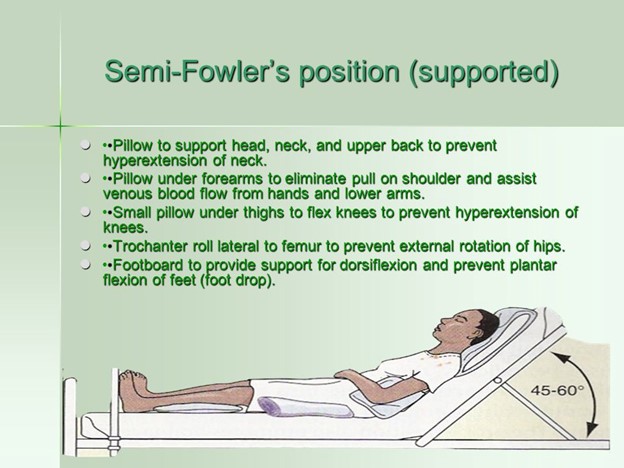A nurse in an emergency department is caring for a client who has appendicitis. Which of the following actions should the nurse take?
Maintain the client in a semi-Fowler's position.
Administer an enema 1 hr prior to surgery.
Apply a warm pack to the client's lower abdomen.
Place the client on a clear liquid diet.
The Correct Answer is A
Choice A rationale:

The nurse should maintain the client in a semi-Fowler's position to promote comfort and reduce the risk of complications related to appendicitis. This position helps to decrease pressure on the abdomen and may alleviate pain by reducing tension on the abdominal muscles.
Choice B rationale:
Administering an enema 1 hour prior to surgery is not indicated for a client with appendicitis. Enemas are generally not recommended for clients with suspected or confirmed appendicitis as they can potentially worsen inflammation and cause perforation of the inflamed appendix.
Choice C rationale:
Applying a warm pack to the client's lower abdomen is contraindicated in appendicitis. Heat can exacerbate inflammation and should be avoided in such cases.
Choice D rationale:
Placing the client on a clear liquid diet is not appropriate for appendicitis. Clients with appendicitis are typically NPO (nothing by mouth) to avoid stimulating the gastrointestinal tract and reduce the risk of rupture if surgery is needed.
Nursing Test Bank
Naxlex Comprehensive Predictor Exams
Related Questions
Correct Answer is B
Explanation
Choice A rationale:
An elevated WBC count (11,000/mm²) in a client starting treatment for MRSA infection may indicate an inflammatory response, but it is expected in this scenario, and the priority is not as high as other critical lab values.
Choice B rationale:
A serum pH of 7.25 indicates acidosis, which is a potentially life-threatening condition. In type 1 diabetes mellitus, diabetic ketoacidosis (DKA) is a common complication that can lead to metabolic acidosis. This lab result is a priority as it requires immediate attention.
Choice C rationale:
Hematocrit of 26% in a client with sickle cell disease might be low, but it is not the priority over the critically abnormal lab value of serum pH in option B.
Choice D rationale:
A urine specific gravity of 1.032 in a client diagnosed with dehydration is elevated, indicating concentrated urine due to dehydration. While dehydration is concerning, it is not as high-priority as the potentially life-threatening acidosis in option B.
Correct Answer is A
Explanation
Choice A rationale:
Properly cutting the opening on the skin barrier wafer to fit over the stoma is crucial to prevent any irritation or damage to the surrounding skin. A well-fitted wafer creates a seal around the stoma, reducing the risk of stool coming into contact with the skin, which can cause excoriation.
Choice B rationale:
Emptying the bag when it is three-fourths full of stool is unrelated to the education on colostomy care. This information was provided in the previous question () and is not relevant to colostomy care education.
Choice C rationale:
The color of the stoma should not be slightly purple. A healthy stoma should be pink or red, indicating a good blood supply. A purple or dark-colored stoma could indicate inadequate blood flow, which is a concern and requires immediate medical attention.
Choice D rationale:
Cleansing the peristomal skin with moisturizing soap and water is not the recommended approach. The nurse should use plain water or mild, non-moisturizing soap to clean the peristomal skin, as moisturizing soap may leave a residue that affects the adhesion of the skin barrier wafer.
Whether you are a student looking to ace your exams or a practicing nurse seeking to enhance your expertise , our nursing education contents will empower you with the confidence and competence to make a difference in the lives of patients and become a respected leader in the healthcare field.
Visit Naxlex, invest in your future and unlock endless possibilities with our unparalleled nursing education contents today
Report Wrong Answer on the Current Question
Do you disagree with the answer? If yes, what is your expected answer? Explain.
Kindly be descriptive with the issue you are facing.
